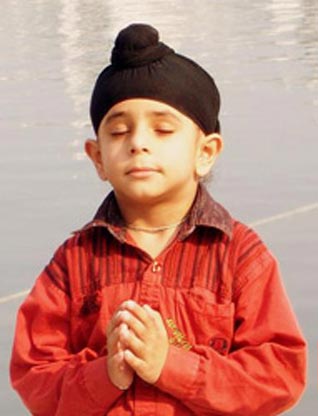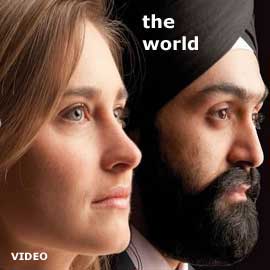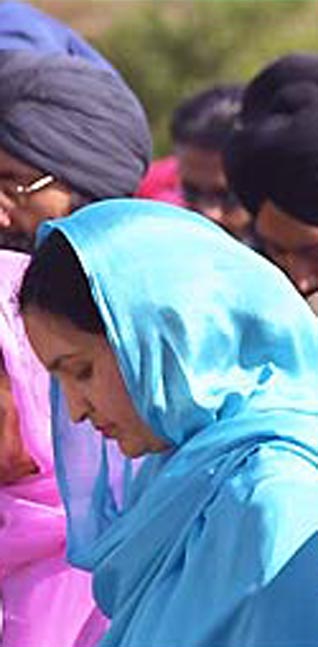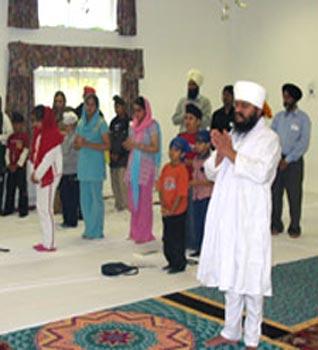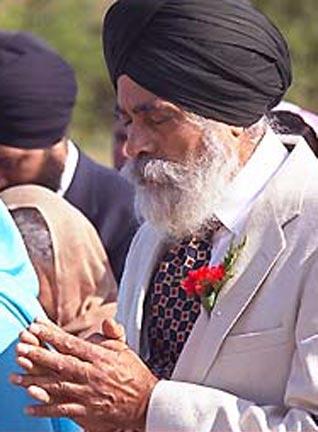Columnists
Ardaas: Philosophy, Form & Practice
The Talking Stick Colloquium # 33, October 25 - 31
Convenor: RAVINDER SINGH TANEJA
THE TOPIC THIS WEEK
The title of this week's colloquium is a give away. Yes, we intend to stop, pause and take a fresh look at the congregational prayer known as Ardaas - its essence, evolution and current practice. This will serve as a good supplement to the current Roundtable Open Forum on Prayer, concurrently running on sikhchic.com..
Oftentimes, we miss the obvious. Until I read Dr. Jaswant Singh Neki's book, Ardaas: Darshan, Roop, Abhiyas some years ago, I had never paid much attention to the ardaas, treating it much like a routine that happened at the gurdwara, at a Sikh
event or at a rite of passage.
Reading the book was another one of those "wow" or "wah" moments for me. I came to appreciate - yet again - the genius of Sikhi for gifting us a unique gem of an ardaas: at once a prayer, a challenge, a resolution and a remembrance.
For this discussion, I have borrowed freely from Dr. Jaswant Singh's book as well as an essay that I co-authored with Dr. I.J Singh entitled, "On Faith, Grace and Prayer," being a review of Dr. Satnam Kaur's book, Three Basics of Sikh Religious Thought.
Incidentally, the title of this week's column is borrowed from Dr Jaswant Singh's book.
THE SIKH PRAYER
The word 'Ardaas' is believed by some scholars to be a derivative of the Persian "Arzdashat", which means a petition or the presetation of one. Others suggest that it is a Sanskrit compound word made up of "Aradan" and "aas" or the act of pleading.
For Sikhs, ardaas should be viewed as a petition reflecting the collective consciousness of the Panth, through which corporate concerns as well as individual pleas can be expressed as a way of seeking the welfare of humanity (sarbat da bhalla).
Traditional accounts suggest that the tradition of congregational ardaas began during Guru Nanak's times when he advised his Sikhs to do ardas with folded hands when feeling helpless. This practice was continued by the Second, Third and Fourth Masters. Guru Arjan started the practice of doing ardaas facing the Adi Granth (then known as 'Pothi Sahib') after its investiture in the Darbar Sahib.
It is believed that the present form of the ardaas can be attributed to Bhai Mani Singh, although there is no documentary evidence for this. Shorter forms of the ardaas exist (on paper), which can be traced to Guru Gobind Singh's time.
The Sikh congregational prayer is a unifying force for all Sikhs - the practice and repeated assertion of the credal statement, 'dhyan dhar ke bolo jee, Waheguru', followed by the collective pride in recalling our spiritual martyrs: 'jinnah singhaa(n) singhniaa(n) nay dharam haith sees ditaah', and listing the common institutions, 'panjaa(n_takhtaa(n) sarbat gurdwaariaa(n) da dhian dhar kay' - all these inspire and bond Sikhs together through a collective process of honouring our history.
The significant thing is that the Khalsa has had to earn every deed, every action, every sacrifice. These are not empty words: The Five Beloved Ones (panj pyarey); the four princes (chaar sahibzaadey); the forty liberated ones (chaali muktey) and an
assortment of spiritual warriors (hatth, jap, tap) have all earned their stripes.
In celebrating their martyrdom with pride and honor, the Ardaas is also an epistle of victory for the Sikhs as well the taking of an oath, a resolve to strive for universal harmony, to seek the welfare of all humanity (sarbat da bhalla), to sacrifice for the larger good.
Lastly, the ardaas is a prayer invoking blessings for a successful venture or mission, or victory in a just cause.
But in all this, one thing remains constant: Naam and its remembrance remains central and foundational.
LET'S PONDER TOGETHER
Nowhere in the ardaas is there a provision for individual gain or prosperity. What, then, do you make of our impulse to pervert a prayer by treating Waheguru as a kind of answering service that you can call for a myriad of reasons? Or, as the satirist Ambrose Bierce likened prayer to "asking that the laws of the universe be annulled on behalf of a single petitioner, confessedly unworthy."
The world around us teaches us to be self-reliant: fend for yourself, be your own person, etc. Prayer is an acknowledgement of dependency on a greater power. How do we square the two?
As Sikhs, we are taught to walk in Hukam and accept the Will of God. If so, why petition for intercession? A caring God must surely know our needs better than we do. So why bother with prayer?
More next week
October 25, 2010
Conversation about this article
1: Nirmal (Saskatoon, Saskatchewan, Canada), October 25, 2010, 11:18 AM.
Dr. Jaswant Singh Neki's book, "Ardaas: Darshan, Roop, Abhiyas" is a MUST read book. It makes you to realize how important, valuable and powerful is the Sikh ardaas. It is the most powerful book written on ardaas I have ever come across. Life would never be the same afterwards.
2: Gurinder Singh (Stockton, California, U.S.A.), October 25, 2010, 12:26 PM.
The beginning of ardaas paurri was prevalent in Guru Gobind Singh ji's time even before the formation of the Khalsa. I have seen a tablet of such ardaas with a professor who teaches in a University of California. This tablet is dated sometime around 1690 AD.I wish he would come forward to share it with the community.
3: Mohan Singh (Toronto, Ontario, Canada.), October 25, 2010, 10:42 PM.
Ardaas is to remain attached with Waheguru through your conscious mind. It is true that 'Bin Bolayaa(n) sub kichh jaanda' and He gives at the right time. But remembering Waheguru and reading or listening bani is to learn to live in Hukam, and He gives us the gift of tolerance too. Our panthic ardaas is also our history in brief that we remember several times every day. Giani Pinderpal Singh of Ludhiana has expressed the meaning of each word of Ardaas in great detail and his complete vyakhyya on ardaas runs over 100 hours: it unfolds the history of our Gurus, Sikhs and Sikhi. It is very interesting.
4: Jasvinder (Hamilton, New Zealand), October 28, 2010, 6:19 PM.
Why bother about prayer? Sometimes I wonder, do we really know what prayer is? Is it just pleading to grant wishes, and let the world around me be as I wish it to be. I have been doing that very religiously, with the right intentions for ages since childhood, but suddenly when one starts pondering about these questions, they take you deeper into the water, rather than just floating on it. I guess we all need to go deep within and search what prayer mean for us? I guess I am still searching ...
5: Mohan Singh (Toronto, Ontario, Canada.), October 29, 2010, 8:28 AM.
Guru Arjan said: "The prayer offered by a humble servant of God never goes in vain" [GGS:819]. Particularly, if you pray for the welfare of others, there is fulfillment. This is my experience.
6: Ravinder Singh Taneja (Westerville, Ohio, U.S.A.), October 31, 2010, 7:14 AM.
To Jasvinder ji's point: the hope is that together we will come to a better appreciation of what prayer (from a gurmat perspective) really means. Thank you, Mohan Singh ji, for sharing. Where can one hear Pinderpal Singh ji's exposition?
7: Mohan Singh (Toronto, Ontario, Canada.), October 31, 2010, 12:05 PM.
Ardaas katha by Bhai (Giani) Pinderpal Singh ji is available online on a few Sikh web sites, one of the links is given here to listen or download: http://www.rajkaregakhalsa.net/sound.htm - click on Katha, click on Bhai Pinderpal Singh ji and again on Ardaas Katha. Another one is: http://smashits.com/ardas-vyakhya-sahit-vol-1-to-79/songs-29873.html
8: Jasvinder (Hamilton, New Zealand), October 31, 2010, 6:15 PM.
I have heard that a prayer that is done with some motivation, some desire to get something out of it, or as result of it, is not a prayer at all. is there any indication like that in gurbani?
9: Mohan Singh (Toronto, Ontario, Canada.), November 01, 2010, 9:28 AM.
Jaswinder ji, you are right: motivation or desire has no place in prayer.
